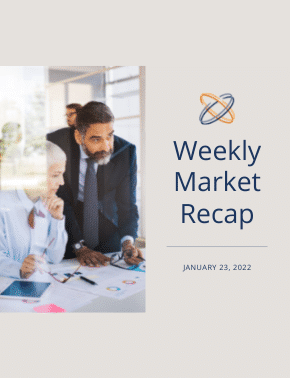Week in Review
Equity Markets:
Stocks struggled for the third week in a row while the market gets acclimated to the new environment. Fed policy and rates are on the top of most investors’ minds. We saw fear expressed in a VIX spike of more than 50% last week. The VIX is a volatility measure of investors’ short-term expectations for the stock market. Tailwinds that were more apparent in 2021 pushed the market consistently higher, driven by low rates, Fed stimulus, and strong earnings growth following 2020. It will take time for the market to get acclimated to the changing landscape that 2022 brings. The current environment is almost the exact opposite of 2021. Rates have spiked, Fed tightening looms, and a normalization of earnings back to the mid to low single digits is setting in.
Fixed Income Markets:
The 10-yr reached as high as 1.9% this week, the highest in over two years, before retreating back to 1.76% on the back of weaker than expected jobs report. We see rates moving into a higher range this year, likely 2% to 2.25%. However, we do not think it is very likely to see rates spike similar to the 1970’s.
There are many factors that have an impact on rates, not just Fed policy. The supply/demand aspect is also very important.
Our economy has fared better than most in the aftermath of the pandemic. China’s central bank cut rates last week in hopes to give a boost to its struggling real estate market. The US Treasury is still one of the highest yielding government bonds in the world. This attracts foreign investment, which will put pressure on rates.
Economic:
Initial jobless claims came in higher than expected, at 286,000 versus 225,000. This marks the third straight week of increases. This was likely influenced by the recent surge in Omicron, and seasonal factors after the holidays. The Census Bureau reported that a survey showed 8.8 million people reported not being at work because of coronavirus-related reasons over the past two weeks. This is up sharply from early December. Health factors aside, this is economically positive news as the Omicron spread wanes. We will likely see these job numbers improve.
There were some mixed numbers reported, The Empire State Manufacturing Index dropped slightly, the first time in 20 months, but the Philadelphia Federal Reserve’s Index of manufacturing conditions rose by eight points. The leading economic indicators index also rose indicating steady economic growth, despite the recent Omicron pressures.
Looking Ahead
Equity Markets:
We expect to see volatility continue in the stock market until the Fed starts down their appropriate course. Uncertainty is what causes days like we saw Thursday: start the day off in the green, only to lose steam and end the day negative.
It looks likely the Fed will have to take action to combat inflation in the near future, although these actions have historically caused volatility to stay heightened. It is important to note that stock markets have historically performed well during raising rates environments.
Earnings season will ramp up next week. Earnings are the driver for stock market growth. A worry that has been expressed is that the higher rate environment will have a negative impact on earnings growth this year. According to FactSet, the S&P has typically seen earnings growth despite the Fed hiking rates. Earnings start to become affected after an extended period of rate hikes.
Fixed Income Markets:
Expect more volatility out of the fixed income markets as investors wait for a policy meeting of the Fed Board members on Wednesday. This meeting could provide valuable insight to where the Fed stands on their policy shift announced last month. As market participants have recently stated they believe there could be four rate hikes this year, Fed guidance and clarity could ease investors’ minds.
The Fed quickly shifted from a very accommodative policy, to a tightening one last month. It is important to note that what the Fed says they are going to do, and what they actually do are different matters. Even more so since the Fed took a “data dependent” stance over the traditional forecasting method. This gives the Fed the flexibility to react as numbers come in. They have indicated their plans to reel in inflation, but the data depended policy allows them to change those plans quickly.
Economic:
It is going to be a busy week for economic numbers. The highly anticipated first estimate for Q4 GDP will be released on Thursday. We will also see the Case-Schiller Home Price Index, Consumer Confidence, Pending Home Sales, and the final read on Consumer Sentiment.
Important Disclosures:
Investment Advisory Services offered through Krilogy®, an SEC Registered Investment Advisor. Please review all prospectuses and Krilogy’s Form ADV 2A carefully prior to investing. This is neither an offer to sell nor a solicitation of an offer to buy the securities described herein. An offering is made only by a prospectus to individuals who meet minimum suitability requirements.
All expressions of opinion are subject to change. This information is distributed for educational purposes only, and it is not to be construed as an offer, solicitation, recommendation, or endorsement of any particular security, products, or services.
Diversification does not eliminate the risk of market loss. Investments involve risk and unless otherwise stated, are not guaranteed. Investors should understand the risks involved of owning investments, including interest rate risk, credit risk and market risk. Investment risks include loss of principal and fluctuating value. There is no guarantee an investing strategy will be successful. Past performance is not a guarantee of future results. Indices are not available for direct investment; therefore, their performance does not reflect the expenses associated with the management of an actual portfolio. The S&P data is provided by Standard & Poor’s Index Services Group.
Services and products offered through Krilogy® are not insured and may lose value. Be sure to first consult with a qualified financial advisor and/or tax professional before implementing any strategy discussed herein.




















